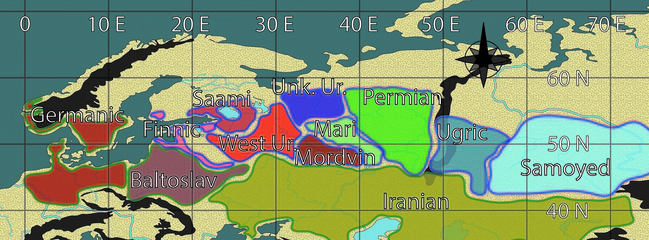Etnofutu – The Ethnofuturism of Fashion
Finland and Northeastern Europe?
Introduction
A foreign audience will most likely not be familiar with the regions and ethnic groups we deal with here. So here's a short history of the Uralic languages, which form the traditional basis of ethnic identification in Finland and that sort of places. Their maximal extension in the Iron Age was pretty much the Boreal Forest regions of Northeastern Europe and Western Siberia – quite a number of cultural features share the same broad area from Neolithic ceramic cultures to cuisine and the sauna. The disturibution of the Y-chromosome haplogroup N1c also fits the same area quite well.
The maps use a subset of my Atlas of European Linguistic History, at this time not available in English. It's at least 80% maps, though, so an enterprising individual should be able to make sense of it.
The Bronze Age
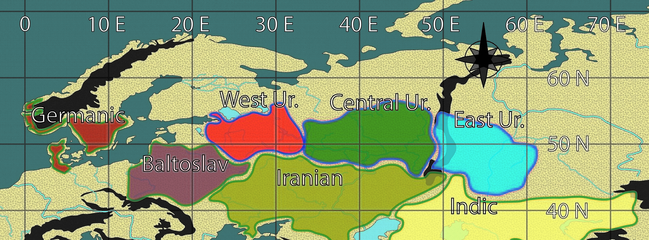 1500 B.C.
1500 B.C.
Let's start off here. The blank bits to the north mean an unknown language – Neolithic Europe is believed to have hosted some 20 to 40 language families, of which a handful remain. The blank bits to the south are, depending on the era, either unknown or Indo-European languages irrelevant for this context.
Coming out of the Stone Age, the Uralic languages have recently had a swift and wide-ranging expansion out of the Central Uralic area. The Western group is now in contact with Baltoslavic languages at the headwaters of the Western Dvina. (Parpola 2013: 150–151, 162–163, 164.) Where they got there is a matter of definition – historical linguistics can't go all that far into the past and is unable to trace the language further than that with any certainty. For our purposes there's something else to go by, though. Historical linguists butt heads over if the Yukaghir languages in Eastern Siberia are related to or influenced by the Uralic ones, but the speakers themselves are biologically related in the light of Y-chromosome studies. Maybe the male line carried the language, maybe not, but it seems likely the languages have the same sort of westbound trajectory as the ancestors of the speakers.
Some notes about the linguistic groups: Western Uralic languages developed into eg. Finnish, Estonian, and the Saami languages, while Hungarian is an offshoot of the Eastern branch. Most other Uralic languages are small and endangered enough to be unheard of for most foreign types. The (future) Germanic languages of course ended up with the likes of Swedish, German and English, Baltoslavic languages with the extremely conservative Lithuanian as well as Slavic languages like Polish and Russian. Iranian languages include Persian quite a bit to the south, as well as a tiny remnant of the Scythian and other steppe Iranian languages in the form of Ossetian in the Caucasus. Indic languages are the Indo-European languages currently of the Indian subcontinent, such as Hindi. They have a wild chase with Iranian languages just offscreen, but you can take a look at the Finnish Atlas for that.
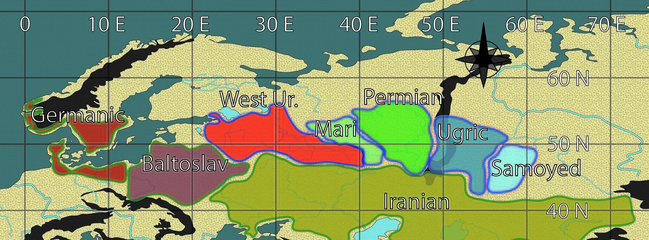
1000 B.C.
By 1000 B.C. there's some fragmentation but not real new expansion. (Aikio 2013: 104; Parpola 2013: 152, 162–163.) The Ugric branch of the Eastern group is the one which results in Hungarian. Back in the 1800's linguistic history was imagined as a very strict tree graph, which you may have sometime seen examples of. Under that model Fenno-Ugric languages were everything west of the Ugric group, Fenno-Permian everything west of the Permian group, and so forth. Research goes on, but popular perceptions not as much – Fenno-Ugric remains a more reality recognized grouping than Uralic, even if it's not really scientifically accurate anymore.
The Iron Age
500 B.C.
This is where we start seeing some real expansion again. The Western group is splitting up after muscling in on Baltoslavic areas in modern Belarus at the headwaters of the Western Dvina: Finnic languages such as Finnish show a very strong Baltoslavic influence in both their grammar and vocabulary, specifically in the sort of things – words for female relatives, for example – that are borrowed very infrequently. This suggests that the Dvina headwaters were a thoroughly multilingual region for quite some time before the Uralic languages won out. (Parpola 2013: 52–53, 104.) The eastern Samoyed group has spread into the entire headwaters of the Ob, and possibly parts of the Yenisei basin as well. (Parpola 2013: 166.) The Permian group is already fragmenting into Udmurt and Komi languages, which suggests an expansion into the north towards modern Komi areas. (Parpola 2013: 162–163.)
You may notice that there's bit labelled Unknown Uralic and there's still a Western Uralic area – that's because those are the sort of places that were later Slavicized very early, and the precise nature of the previous language can't really be got at. In general timing the more northern expansion is difficult, as we know absolutely nothing about the previous languages.
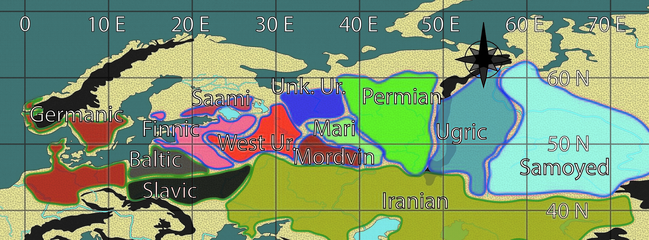
1 A.D.
By this point the Finnic languages are fairly well established in modern Estonia, Latvia and Ingria – where St. Petersburg is today. (Parpola 2013: 153.) The last part is not quite clear – that dongle between Western Uralic and Saami could have at this point been another group at the same "level" as the Finnic and Saami languages. Without period documentation and with early Russian presence at Novgorod, this is likely to stay muddled.
The breakup of the Baltoslavic languages is difficult to time, since they didn't expand anywhere for the longest time. Some authors like to break them up a thousand years before this, but it's really anyone's guess.
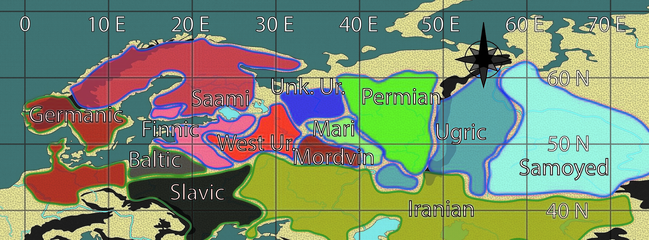
500 A.D.
The Western Roman Empire is gone and the Uralic languages have their peak extension. The expansion of the Saami languages is uncharacteristically well understood: the most western languages have very strong Scandinavian influence, and the contemporary Scandinavian linguistic history can be pieces together from runestones. Thus the contact between them can be fairly accurately timed. (Parpola 2013: 80.) That teal bit west of the Urals are the Hungarians having themselves an adventure. (Parpola 2013: 167.) Finnic languages are growing in Southwest Finland. (Parpola 2013: 95.)
Meanwhile the Slavic languages are starting up with their explosive expansion.
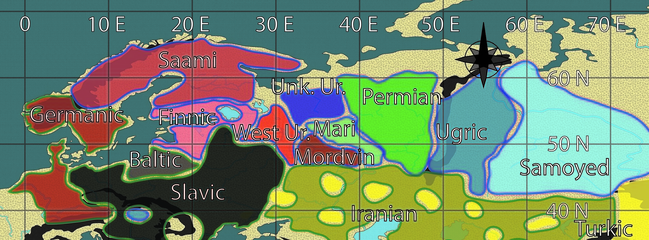
1000 A.D.
Finnic languages finally have a strong foothold in what would become Finland, (Parpola 2013: 97.) and the Hungarians are finally in modern Hungary. A fairly organic expansion of the Finnic and Germanic languages north continue to enroach on the Saami area until the 1700's. From the 1800's on gold rushes in Lapland and centralization efforts lead to their systematic suppression and almost their extinction. The same goes on with other Uralic languages in eventual Russia, of course, and Uralic speakers make up less than 2% of modern Russia.
The hole in the Balkans are the Latins in modern Romania, while the yellow blobs to the east are Turks. Turkic warbands arrive a bit later in eg. Bulgaria and modern Turkey much as Hungarian ones did in modern Hungary. In some cases this sort of military aristocracy manage to assimilate the vast masses of locals – as happened in Turkey and Hungary. Sometimes they get swallowed by their subjects, like in Bulgaria. The original Bulgars were Turks from the Northeast, but despite their name, modern Bulgarians still speak a South Slavic language.
The Turkic languages were thought to be closely related to the Uralic ones back in the 1800's – they would have formed a Turanic group together with Mongolian and Tungusic languages. Grouping any of these four together doesn't have any support in modern linguistics, though. Judging by Y-chromosomes the R-group that most Indo-European speakers fall into is closer to the N-group of the Uralics than either of them to the C-group common in Turkic speaking areas.
